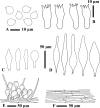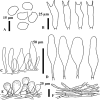Introduction of two novel species of Hymenopellis (Agaricales, Physalacriaceae) from Thailand
- PMID: 37534304
- PMCID: PMC10390987
- DOI: 10.3897/mycokeys.98.104517
Introduction of two novel species of Hymenopellis (Agaricales, Physalacriaceae) from Thailand
Abstract
Hymenopellis is the most diverse genus in the group of oudemansielloid/xeruloid taxa (Physalacriaceae). This genus has a worldwide distribution with records mostly from Europe and America. Asian taxa are least represented. In this paper on Hymenopellis from Thailand, two novel species are introduced, and a Hymenopellis collection affine to H.orientalis is described. Macro and micromorphological characters are described. Maximum likelihood and Bayesian phylogenetic analyses were performed on combined ITS and nrLSU regions to confirm taxonomical placement and infer the phylogenetic affinities of the studied species. Hymenopellisstraminea sp. nov. is straw-yellow, with medium-sized basidiomata, abundant and diverse in form cheilocystidia, few, narrowly lageniform to fusiform pleurocystidia, and clamp connections at the lower part of the stipe. Hymenopellisutriformis sp. nov. has mostly utriform pleurocystidia and 2-spored basidia. In the inferred phylogenies, the new species from this study formed distinct clades well supported by bootstrap proportions and posterior probabilities. The studied specimen affine to H.orientalis produced 2-spored basidia whereas published descriptions of other specimens mention 4-spored basidia. Moreover, the genetic distance between ITS sequences of this specimen and that of a Hymenopellisorientalis specimen from GenBank was 1.30-2.57%. Therefore, the conspecificity of our specimen with H.orientalis is uncertain, and additional specimens are needed to fully confirm its identity.
Keywords: 2 new species; Southeast Asia; macrofungi; morphology; phylogeny; taxonomy.
Allen Grace T. Niego, Naritsada Thongklang, Kevin D. Hyde, Olivier Raspé.
Conflict of interest statement
The authors have declared that no competing interests exist.
Figures







Similar articles
-
Morphological and molecular analyses reveal two new species of Grifola (Polyporales) from Yunnan, China.MycoKeys. 2024 Feb 29;102:267-284. doi: 10.3897/mycokeys.102.118518. eCollection 2024. MycoKeys. 2024. PMID: 38463693 Free PMC article.
-
A new species and new records of Hymenopellis and Xerula (Agaricales, Physalacriaceae) from China.PeerJ. 2023 Dec 20;11:e16681. doi: 10.7717/peerj.16681. eCollection 2023. PeerJ. 2023. PMID: 38144183 Free PMC article.
-
Species Diversity of Edible Mushrooms I-Four New Laccaria Species from Yunnan Province, China.J Fungi (Basel). 2025 Feb 28;11(3):189. doi: 10.3390/jof11030189. J Fungi (Basel). 2025. PMID: 40137227 Free PMC article.
-
Three new species of Gerronema (Agaricales, Basidiomycota) from southern China.MycoKeys. 2025 Mar 4;114:239-258. doi: 10.3897/mycokeys.114.145299. eCollection 2025. MycoKeys. 2025. PMID: 40079028 Free PMC article.
-
Taxonomy, Diversity and Cultivation of the Oudemansielloid/Xeruloid Taxa Hymenopellis, Mucidula, Oudemansiella, and Xerula with Respect to Their Bioactivities: A Review.J Fungi (Basel). 2021 Jan 13;7(1):51. doi: 10.3390/jof7010051. J Fungi (Basel). 2021. PMID: 33451109 Free PMC article. Review.
References
-
- Chandrasrikul A, Suwanarit P, Sangwanit U, Lumyong S, Payapanon A, Sanoamuang N, Pukahuta C, Petcharat V, Sardsud U, Duengkae K, Klinhom U, Thongkantha S, Thongklam S. (2011) Checklist of mushrooms (Basidiomycetes) in Thailand. Office of Natural Resources and Environmental Policy and Planning, Bangkok.
-
- Clémençon H. (1979) Taxonomic structure of the genus Oudemansiella (Agaricales). Sydowia 32: 74–80.
-
- Clémençon H. (2009) Methods for working with macrofungi: Laboratory cultivation and preparation of large fungi for light microscopy. IHW-Verlag, 88 pp.
LinkOut - more resources
Full Text Sources
